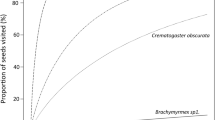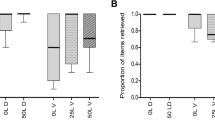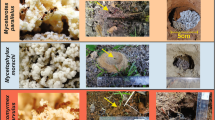Abstract
In ant gardens of lowland Amazonia, parabiotic ant speciesCamponotus femoratus andCrematogaster cf.limata parabiotica cultivate a taxonomically diverse group of epiphytic plants, whose establishment is restricted to arboreal carton ant nests. Epiphyte seeds are collected by workers ofCa. femoratus, the larger of the two ants, and stored unharmed in brood chambers where they subsequently germinate. Although seeds of some ant-garden epiphytes bear nutritional rewards, previous studies have shown that these rewards are not sufficient to explain the pattern of ant attraction to seeds. Five aromatic compounds occur frequently in and on the seeds of most ant-garden epiphytes and may be chemical cues by which ants recognize propagules of their symbiotic plants. The most widely distributed of these is methyl 6-methylsalicylate [6-MMS]1, previously reported as a major mandibular gland product in relatedCamponotus species and present in trace quantities inCa. femoratus males. (−)-Citronellol6 (previously unreported inCamponotus) was the principal volatile constituent in extracts of male heads, and (−)-mellein7 was present in small quantities. Discovery of 6-MMS inside the mandibular glands of maleCa. femoratus (and its presence in analogous glands of related ants) offers preliminary support for Ule's (1906) hypothesis that seeds attract ants by mimicking ant brood. In addition, the likely fungistatic activity of seed compounds suggests that they could retard microbial pathogens of ants and plants in the organic detritus of nest gardens. While the presence of identical seed compounds in so many unrelated plant lineages might represent a remarkable case of convergent evolution, other interpretations are possible.
Similar content being viewed by others
References
Arakawa, H., Torimoto, N., andMasui, Y. 1969. Bestimmung der absoluten Konfiguration von Agimonolid und Mellein.Liebigs Ann. Chem. 728:152–157.
Asahina, Y., andKondo, Y. 1922. 3-Hydroxy-o-toluic acid.J. Pharm. Soc. Jpn. 482:264–271.
Attygalle, A.B., Siegel, B., Vostrowsky, O., Bestmann, H.J. andMaschwitz, U. 1989. Chemical composition and function of metapleural gland secretion of the ant,Crematogaster deformis Smith (Hymenoptera: Myrmicinae).J. Chem. Ecol. 15:317–328.
Auwers, K., Lechner, M., andBundesmann, H. 1925. Zur Kenntnis der Beckmannschen Umlagerung (III.)Chem. Ber. 58:36–51.
Biedermann, R., andPike, W.A. 1873. Ueber Kresotinsäure.Chem. Ber. 6:323.
Birkinshaw, J.H., andBracken, A. 1942. Synthesis of compounds related to mould metabolic products. Part I. 3,5-Dihydroxy-2-formylbenzoic acid and 3,5-dihydroxyphthalic acid.J. Chem. Soc. 1942:368–370.
Blum, M.S., Padovani, F., andAmante, E. 1968a. Alkanones and terpenes in the mandibular glands ofAtta species (Hymenoptera: Formicidae).Comp. Biochem. Phys. 26:291–299.
Blum, M.S., Padovani, F., Herman, Jr., H.R. andKannowski, P.B. 1968b. Chemical releasers of social behavior. XI. Terpenes in the mandibular glands ofLasius umbratus.Ann. Entomol. Soc. Am. 61:1354–1359.
Blum, M.S., Morel, L., andFales, H.M. 1987. Chemistry of the mandibular gland secretion of the antCamponotus vagus.Comp. Biochem. Phys. 866:251–252.
Bowie, J.H., Ronayne, J., andWilliams, D.H.J. 1967. Solvent effects in nuclear magnetic resonance spectroscopy. Part X. Solvent shifts induced by benzene in ortho- and meta-substituted methoxybenzenes.J. Chem. Soc. (B) 1967:535–540.
Brand, J.M., Duffield, R.M., MacConnell, J.G., Blum, M.S., andFales, H.M. 1973a. Caste-specific compounds in male carpenter ants.Science 179:388–389.
Brand, J.M., Fales, H.M., Sokoloski, F.A., MacConnell, J.G., Blum, M.S., andDuffield, R.M. 1973b. Identification of mellein in the mandibular gland secretions of carpenter ants.Life Sci. 13:201–211.
Carpenter, M.S., andEaster, W.M. 1955. The isopropyl cresols.J. Org. Chem. 20:401–411.
Claisen, L., andEisleb, O. 1913. Über die Umlagerung von Phenolallyläthern in die isomeren Allylphenole.Liebigs Ann. Chem. 401:21–119.
Clewer, H.W.B., Green, S.J., andTutin, F. 1915. The constituents ofGloriosa superba.J. Chem. Soc. 107:835–846.
Cremer, S.E., andTarbell, D.S. 1961. The Fries reaction of 2,4-dichloro-5-methylphenyl acetate.J. Org. Chem. 26:3653–3657.
Danishefsky, S., Prisbylla, M.P., andHiner, S. 1978. On the use oftrans-methyl-β-nitroacrylate in Diels-Adler reactions.J. Am. Chem. Soc. 100:2918–2920.
Davidson, D.W. 1988. Ecological studies of Neotropical ant gardens.Ecology 69:1138–1152.
Davidson, D.W., andEpstein, W.W. 1989. Epiphytic associations with ants. Chapter 8,in U Lüttge (ed.). Vascular Plants as Epiphytes. Springer-Verlag, New York. 200–233.
Davies, W.H., andSexton, W.A. 1946. Chemical constitution and fungistatic action of organic sulphur compounds.Biochemistry 40:331–334.
Dekiewiet, T.E., andStephen, H. 1931. 2-Hydroxy-4-methoxy- and 4-hydroxy-2-methoxy benzaldehydes.J. Chem. Soc. 1931:84–85.
Eliel, E.L. 1951. The structure of the guaiacol “Mannich bases”.J. Am. Chem. Soc. 73:43–45.
Eliel, E.L., Rivard, D.E., andBergstahler, A.W. 1953. The synthesis of 6-formylsalicylic acid, esters of 6-bromomethylsalicylic acid, and related substances.J. Org. Chem. 18:1679–1688.
Elix, J.A., andFerguson, B.A. 1978. Synthesis of the lichen depsides, olivetoric acid, confluentic acid and 4-o-methylolivetoric acid.Aust. J. Chem. 31:1041–1051.
Fujikawa, F., Sawaguchi, G., andTakimura, M. 1952. Antiseptics for foodstuff LIII.J. Pharm. Soc. Jpn. 72:1033–1036.
Funke, A., andGombert, R. 1959. Synthesis of 2-methoxy-3-hydroxybenzaldehyde.Comp. Rend. 249:2084–2088.
Gottig, C. 1876. Üeber zwei Äethyl-Derivate der Salicylsäure.Chem. Ber. 9:1473–1475.
Greathouse, G.A., andRigler, N.B. 1940. The chemistry of resistance of plants to phymatotrichum root rot. IV. Toxicity of phenolic and related compounds.Am. J. Bot. 27:99–108.
Hartshorn, M.P., andWallis, A.F.A. 1964. Some addition reactions of β-pinene derivatives.J. Chem. Soc. 1964:5254–5260.
Hayakawa, M., Hayashi, M., andKamuro, Y. 1977. Japan Kokai 76,100,033.Chem. Abs. 86:38592h.
Hölldobler, B., andEngel-Siegel, H., 1984. On the metapleural glands of ants.Psyche 91:201–224.
Hölldobler, B., andMaschwitz, U. 1965. Der Hochzeitsschwarm der RossameiseCamponotus herculeanus L. (Hym. Formicidae).Z. Vergl. Physiol. 50:551–568.
Jones, T.H., Blum, M.S., andFales, H.M. 1981. A facile synthesis of 2-hydroxy-6-methyl-acetophenone.Synth. Commun. 11:889–894.
Julia, M., andChastrette, F. 1962. Sur quelques acides salicyliques portant en-4 une chaine acide aliphatique.Bull. Soc. Chim. Fr. 1962:2255–2261.
Kistner, D.H. 1979. Social and evolutionary significance of social insect symbionts, pp. 340–413, in H.R. Hermann (ed.). Social Insects, Vol. 1. Academic Press, New York.
Kleinfeldt, S. 1978. Ant-gardens: The interaction ofCodonanthe crassifolia (Gesneriaceae) andCrematogaster longispina (Formicidae).Ecology 59:449–456.
Kleinfeldt, S. 1986. Ant-gardens: mutual exploitation, pp. 283–294, in B. Juniper and T.R.E. Southwood (eds.). Insects and the Plant Surface. Edward Arnold, London.
Kurita, N., Miyaji, M., Kurane, R., andTakahara, Y. 1981. Antifungal activity of components of essential oils.Agric. Biol. Chem. 45:945–952.
Law, J.H., Wilson, E.O., andMcCloskey, J.A. 1965. Biochemical polymorphism in ants.Science 149:544–546.
Leifertova, F., Hejtmankova, N., Hlava, H., Kudrnacova, J., andSantavy, F. 1975. Antifungal and antibacterial effects of phenolic substances.Acta Univ. Palacki Olomuc., Fac. Med. 74:83–101.
Madison, M. 1979. Additional observations on ant-gardens in Amazonas.Selbyana 5:107–115.
Mali, R.S., Yadav, V.J., andZaware, R.N. 1982. An improved synthesis of naturally occurring coumarins: Synthesis of herniarin, scoparone and 7-methoxy-6-methylcoumarin.Indian J. Chem. 21B:759–760.
Martens, J., andPraefuke, K. 1974. Photochemishe α-Spaltung von Thiobenzosaure-s-p-tolylestern in Lösung.Chem. Ber. 107:2319–2325.
Maschwitz, U. 1974. Vergleichende Untersuchungen zur Funktion der Ameisenmetathorakaldruse.Oecologia 16:303–310.
Mauthner, F. 1919. Die Synthese des Metadimethoxybenzaldehyds.J. Pracht. Chem. 100:176–182.
Mauthner, F. 1927. Die Synthese eines neuen Resorcylaldehyds.J. Pracht. Chem. 116:314–320.
Messer, A.C. 1985. Fresh dipterocarp resins gathered by megachilid bees inhibit growth of pollen-associated fungi.Biotropica 17:175–176.
Patterson, E.L., Andreo, W.W., andBohonos, N. 1966. Isolation of the optical antipode of mellein from an unidentified fungus.Experientia 22:209–210.
Payne, T.L., Slum, M.S., andDuffield, R.M. 1975. Chemoreceptor responses of all castes of a carpenter ant to male-derived pheromones.Ann. Entomol. Soc. Am. 68:385–386.
Prance, G. 1973. Gesneriads in the ant gardens of the Amazon.Gloxian 23:27–28.
Regnier, F.E., andWilson, E.O. 1968. The alarm-defence system of the antAcanthomyops claviger.J. Insect Physiol. 14:955–970.
Rosenmund, K.W., andSchnurr, W. 1928. Über Acylwanderungen an Phenolin.Liebigs Ann. Chem. 460:56–98.
Schamschurin, A.A. 1944. A new synthesis of γ-resorcylaldehyde.Z. Obsch. Chem. 14:211–215;Chem. Abs. 1945:2286.
Schildkneckt, H., andKoob, K. 1970. Plant bioregulators in the metathoracic glands ofMyrmicine ants.Angew. Chem. Int. Engl. Ed. 9:173.
Schildkneckt, H., andKoob, K. 1971. Myrmicacin, the first insect herbicide.Angew. Chem. Int. Engl. Ed. 10:124–125.
Schmidt, H. 1944. Zur Raumisomerie in der Pinanreihe (IV. Mitteil.): Pinocarvon und die beiden diastereomeren Pinocarveole.Chem. Ber. 77:167–172.
Sen, A.B., andJoshi, K.C. 1952. Search for organic fungicides: Chemical constitution and fungicidal activity.J. Sci. Food Agric. 3:526–531.
Seidel, J.L. 1988. The monoterpenes ofGutierrezia sarothrae: Chemical interactions between ants and plants in neotropical ant-gardens. Dissertation. University of Utah, Salt Lake City, Utah.
Spath, E., andKromp, K. 1941. Synthese des Pinosylvin-Monomethyläthers (V. Mitteil, über natürliche Stilbene).Chem. Ber. 74:1424–1428.
Terborgh, J. 1983. The Behaviorial Ecology of Five New World Primates. Princeton University Press, Princeton, New Jersey.
Tiemann, F., andMÜller, W.H.M. 1881. Ueber Abkömmlinge des Hydrochinons.Chem. Ber. 14:1985–1999.
Ule, E. 1901. Ameisengarten im Amazonas-gebiet.Englers Bot. Jahrb. 30:45–51.
Ule, E. 1905. Wechselbeziehungen zwischen Ameisen und Pflanzen.Flora 94:491–497.
Ule, E. 1906. Ameisenpflanzen.Engler's Bot. Jahr. 37:235–352.
Ulrich, H., Rao, D.V., Tucker, B., andSayigh, A.A.R. 1974. Selective demethylation of 2,5-dimethoxybenzaldehyde to 5-hydroxy-2-methoxybenzaldehyde.J. Org. Chem. 39:2437–2438.
Wheeler, W.M. 1921. A new case of parabiosis and the “ant-gardens” of British Guiana.Ecology 2:89–103.
Wheeler, W.M. 1942. Studies of neotropical ant-plants and their ants.Bull. Mus. Comp. Zool., Harvard 90:1–262.
Author information
Authors and Affiliations
Rights and permissions
About this article
Cite this article
Seidel, J.L., Epstein, W.W. & Davidson, D.W. Neotropical ant gardens. J Chem Ecol 16, 1791–1816 (1990). https://doi.org/10.1007/BF01020495
Received:
Accepted:
Issue Date:
DOI: https://doi.org/10.1007/BF01020495




